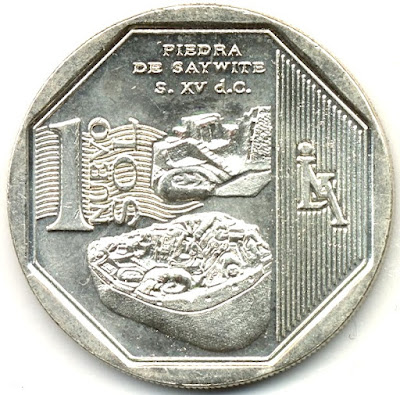3119) "Sayhuite (or "Sigh-weetey" or "Say White") Stone," Peru: "Riqueza y Orgullo del Peru” ("Wealth and Pride of Peru Coin Series"): A 1 (One) Sol Coin showcases the Say White stone which served as a topographic hydraulic model for several generations: Date/Year of Coin issue: 2012:
The Central Reserve Bank of Peru in 2010 unveiled the design for one-sol coins, in its numismatic series called “Riqueza y Orgullo del Peru” ("Wealth and Pride of Peru").
The "Wealth and Pride of Peru" series first began in 2010 with the issue of the Golden Tumi as its motif.
Successive coins were issued such as the Karajia Sarcophagi, the Estela de Raimondi, the Chullupas of Sillustani, Machu Picchu, the Monastery of Santa Catalina, the Saywite Stone, the Great Pajaten, the Real Felipe Fortress, and the Temple of Vilcashuamán, and the Ruins/Monolith of Kuntur Wasi.
The Coins launched in this one-sol series included 26 unique designs reflecting Peru’s history and traditions.
"Sayhuite" (or "Sigh-weetey" or "Say White") Stone:
Sayhuite is an archaeological site 47 kilometres (29 mi) East of the city of Abancay, about 3 hours away from the city of Cusco, in the province Abancay in the region Apurímac in Peru.
The site was a centre of religious worship for Inca people, focussing on water.
The Temple featured larger columns draped in fabrics with gold bands the "thickness of one's hand." The temple was also under the care of the priestess Asarpay, who jumped to her death in the nearby 400 metre gorge to avoid capture by Spanish forces.
An important feature on the site is the Sayhuite Monolith, an enormous rock containing more than 200 geometric and zoomorphic figures, including reptiles, frogs, and felines.
Found at the top of a hill named Concacha, the stone was sculpted as a topographical hydraulic model, complete with terraces, ponds, rivers, tunnels, and irrigation channels.
The Monolith was used as a scale model to design, develop, test, and document the water flow for public water projects, and to teach ancient engineers and technicians the concepts and practices required.
The Monolith was "edited" several times, with new material, either altering the paths of the water or adding routes altogether.
About two metres long, and four metres wide, the Monolith is the most popular attraction on the archaeological site.
Significance of the Monolith:
While the creators remain a mystery, the Monolith provides archaeologists with insight into the culture of the Incan population.
Archaeologists have determined that the site was an Incan religious centre, where rituals and ceremonies for the worship of water was conducted.
The Monolith is an important clue to this, since it depicts a water-like flow between the carvings.
Carvings in its upper part represent terraces, irrigation canals, pumas, and other animals, such as lizards were a symbolic representation of the valley.
While the precise meaning of this stone still remains a mystery, the Monolith is part of the material culture of the Incan people, and as such helps archaeologists piece together how and why they lived this way.
The Commemorative Coin:
Inscribed towards the upper periphery is the inscription - "TUMI DE ORO - S. XV d.C.". Vertically engraved is seen "1 NEUVO SOL".
The specifications of the One Sol Coin are:
Country of issue: Republic of Peru; Coin Series Theme: "Riqueza y Orgullo del Peru” ("Wealth and Pride of Peru Coin Series"); Coin Theme: "Sayhuite" (or "Sigh-weetey" or "Say White") Stone"; Coin Quality: Circulation Commemorative Coin; Date/Year of Coin issue: 2012; Denomination of Coin: 1 (One Nuevo Sol); Metal Composition: Nickel-brass; Weight: 7.32 grams; Diameter/Size: 25.5 mm; Thickness: 1.9 mm; Minted By: National Mint House; Mint Mark: LIMA; Mintage: 10.00 Million pieces; Shape: Round; Technique: Milled; Orientation/Coin alignment: ↑↓; Edge: Reeded. "Sayhuite" (or "Sigh-weetey" or "Say-White") Stone."
Links to Posts on Peru:
Links to Posts on Argentina:
Links to Posts on Guyana:
1) A $500 (Five Hundred Dollars) Banknote issued by the Bank of Guyana
Links to Posts on Turks and Caicos Islands:
Links to Posts on Curacao on this Blog:
For some other interesting posts on Currencies of the Caribbean Sea and the Atlantic Ocean, please visit the following links:
18) Sea Motifs, Bahamas: Gold Bullion Coins in the denominations of 100 Dollars (depicting a Blue Marlin) and 250 Dollars (depicting a Conch Shell): Coins issue date: 03.12.2019
19) A new Generation $100 Polymer Banknote, Trinidad and Tobago with enhanced security features to "raise the bar" for counterfeiters & unscrupulous elements: Banknote circulation date: 09.12.2019:
20) Festival di Tumba (Carnival of Curacao), Curacao: "50th Edition of the Curacao Carnival/Festival" held from 27-31.01.2020: A set of six Commemorative Postage Stamps brought out by Cpost (Curacao Post) on 20.02.2020
21) New Polymer Banknotes, Trinidad and Tobago: The entire series will consist of $100, $50, $20, $10, $5 and $1 denominations: $100 has already been issued on 09.12.2019
23) "Caribbean Sea-Horse", Barbados: $10 (Ten Dollars) 1.0 Oz. Gold Bullion Coins & $1 (One Dollar) 1.0 Oz. Silver Bullion Coins minted by the Scottsdale Mint; Year of issue: 2020
24) Cayman Islands, A British Overseas Territory (BOT): A set of identically numbered Banknotes of the presently circulating Banknotes from the "D" Series of Banknotes
Links to some other interesting posts from South American countries & Mexico:
26) A new 100 Boliviano Banknote from Bolivia: issued by the "Banco Centrale de Bolivia" (Central Bank of Bolivia) on 15.01.2019 under its new 2018 Banknote Series
27) Central Bank of Uruguay ("Banco Centrale del Uruguay"): 50th Anniversary (Golden Jubilee) - 1967-2017 - celebrated with the issue of a 50 Peso Commemorative Banknote on 14.09.2018
Links to Posts on Curacao on this Blog:


Santosh Khanna has commented:
ReplyDelete"Thanks for sharing this interesting post."
Thank you so much, Khanna sahab.
Delete